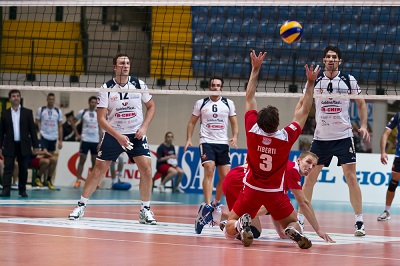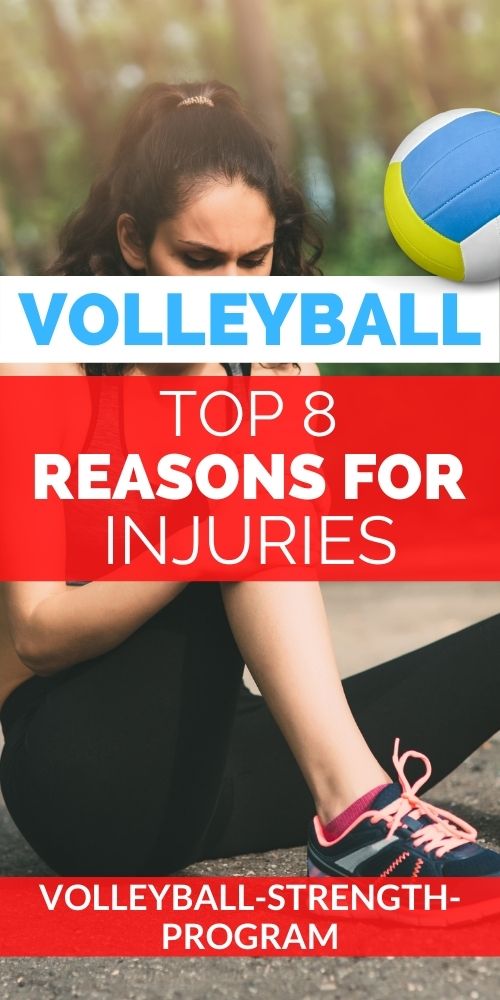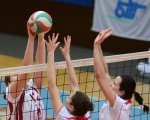LESSON 6:
Volleyball Injuries...Top causes and how to avoid them
Volleyball injuries related to tendon, ligament or joint pain are common problems faced by strength training athletes.
At one time or another, you likely have heard a volleyball player say, My shoulder is killing me, or This knee
has been aching for months, or I cant doing anything that involves bending because it hurts my low back.
It would be more comforting to believe that injury prevention is
not a hot topic because volleyball injuries are very uncommon, but we know this is not true.
If you have a history of injury or a present problem, it needs to be fixed. Even better,
lets prevent the potential for volleyball injuries
altogether.

Top 8 Causes of Volleyball Injuries
1. Not Warming-up. If you have never warmed up and have never been injured, consider yourself lucky.
A warm up is a great insurance policy against a strain or injury.
Even though warming up is highly subjective, I
recommend that everyone spend a few minutes warming up before a volleyball strength training
workout.
The best way to warm up depends on your age, your level of conditioning, and your history
of injury. The purpose of warming up is to get blood rushing through your body and to allow a few minutes to mentally
rehearse your goals for the hard workout you are about to do.
2. Training Too Often. Your volleyball strength program likely
has splitting exercises. For example, one day may focus more on upper
body, while the next
day you focus more on training the lower body. A splitting routine has
its benefits, but its
benefits are counteracted when you train too often.
Its not just your muscles that require recovery, but also your organs, joints, hormonal
systems, and
nervous system all need adequate time to recover from volleyball training.
These vital systems can be overworked too, and just because you feel
rested doesn't mean these other systems have fully recovered.
Your structural system doesn't care that you worked your upper body yesterday and are giving it
a break by training your legs today. Its all the same to your tendons, ligaments and joints.
I assume you want steady and consistent gains so don't underestimate the other
systems in your body.
3. Psychological Influence. Studies have shown that athletes who are aggressive, tense, and compulsive have
a higher risk of injury. Tension may make muscles and tendons
more taut, increasing the risk that they will be harmed during workouts.
However, dont underestimate the value of psyching yourself up prior to a weight
training session.
Similar to other life goals, improvement requires a sense of focus and purpose prior to
each workout. To make progress, you must reach a greater muscular capacity creating potential for muscle growth which means
todays workout must be better than your last workout.
4. Choosing the Wrong Weight. Even though our goals are improving strength and power
for volleyball, there are still times when you
could choose a weight that will compromise your form and put you at risk for
volleyball injuries. Not only will
your form be incorrect but you will lose the isolation on the muscle. Remember, your
muscles can not read the amount of weight on the plates. Yes, muscular overload
must be attained with heavy lifts but the progress must be consistent and gradual.
Inch by inch life is a cinch. Yard by yard life is hard! Your goal is to stimulate your muscles - not your joints.
Oftentimes choosing a weight that is outside our limits will transfer the stress to your
tendons, ligaments and joints.
Most trainees have no idea until a few days later when they cant figure out why the
heck their lower back, shoulder, and knees are killing them. Worse yet, most young trainees
who are currently lifting outside their limits will have no clue until 5-10 years from
now when their neck and shoulder start hurting and they have to start spending hundreds
of dollars on therapy.
6. Inadequate Nutrition. Most joint problems, such as arthritis, tendinitis, and bursitis, can be reduced with
natural compounds that can save you from aching joints and years of pain. The sad
news is that most treatments offered by traditional medicine simply treat the symptoms
and make the problem worse in the long run.
Common doctor recommendations
of anti-inflammatory drugs, injections, joint replacement and stay off it advice are
useless and could be avoided if the proper measures were taken years ago.
Supplement with flax oil at least three times a day to help reduce inflammation in
the joints, which will also help reduce pain from heavy lifting. Glucosamine is considered
by many as one of the best natural products for the treatment and prevention
of cartilage degeneration. It is an essential part of cartilage, synovial fluid, and other
components of joints. Chondroitin sulphate is related to glucosamine and acts like flax
oil helping to reduce inflammation around the joints. Also, the antioxidants Vitamin E
and C should be added because it is well known that free radical pathology is part of
the damage that takes place in the joints.
7. Using Inappropriate Range-of-Motion.
Many volleyball injuries occur when training in the weakest part of the motion. For example,
the bottom of the squat position places outrageous stress on the knees and the bottom
of the bench press position can tear the ligaments and tendons of the upper arm
and shoulder.
However, lifting heavy with a full range of motion is acceptable and will stimulate
more muscle tissue if you have gradually progressed with a slower and controlled
movement and then progressively add resistance. If you are training with full
range movements and have limiting flexibility issues in certain joints,
only train within your current range.
8. Not Stretching Enough.
Studies show that shortened muscles perform weaker, slower and have a
higher
incidence of volleyball injuries. But big muscles require strong,
lengthened and healthy tissue. Performing exercises that prevent
volleyball injuries is an important component of your fitness that can
improve muscle strength, help maintain healthy joints, and
accelerate recovery.
Volleyball › Coaching Lessons › Volleyball Injuries
ACCESS MY STRENGTH SECRETS




